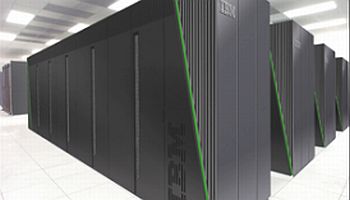IBM Makes Blue Gene/Q Official

Big Blue’s 100 petaflop Blue Gene is also green, giving two gigaflops per Watt.
Computing giant IBM this week officially launched the Blue Gene/Q (BGQ) project, the third generation in the Blue Gene family of supercomputers.
The ultra-scale technical computing platform, operates at an order of magnitude faster than previous systems, with a scalable peak performance of up to 100 petaflops, according to the company. With an output of two gigaflops per Watt, it is is already ranked as the most energy efficient supercomputer in the world by Green500.
Solving the world’s problems
 The BGQ platform has the capability to solve the most challenging problems facing engineers and scientists, says IBM, at faster, more energy efficient, and more reliable rates than ever before. It is expected to predict the path of hurricanes, analyse the ocean floor to discover oil, decode gene sequences and simulate nuclear weapons performance.
The BGQ platform has the capability to solve the most challenging problems facing engineers and scientists, says IBM, at faster, more energy efficient, and more reliable rates than ever before. It is expected to predict the path of hurricanes, analyse the ocean floor to discover oil, decode gene sequences and simulate nuclear weapons performance.
“Completing computationally intensive projects for a wide variety of scientific applications that were previously unsolvable is not just possible – it is now probable,” said vice president of technical computing at IBM, Brian Connors, in statement.
The platform employs the new PowerPC A2 processing architecture and each processor includes 16 compute cores, up from four used in the previous system, plus a core allocated to operating system administrative functions and a redundant spare core.
The BGQ was engineered with fewer moving parts and built in redundancy than previous Blue Gene machines, while its low latency, high performance runs are all based on an open source and standards-based operating environment.
The platform also incorporates architectural advances that contribute to the system’s performance and help simplify programming. “Hardware-based speculative execution capabilities facilitate efficient multi-threading for long code sections, even those with potential data dependencies,” said the IBM statment. “If conflicts are detected, the hardware can backtrack and redo the work without affecting application performance,while hardware-based transactional memory helps programmers avoid the potentially complex integration of locks and helps eliminate bottlenecks caused by deadlocking. It helps deliver efficient and effective multi-threading while reducing the need for complicated programming,” said IBM.
Already in the pipeline
Multidisciplinary national security laboratory, Lawrence Livermore National Laboratory (LLNL), will run a 20 petaflop system named Sequoia , with IBM deploying 96 racks at the facility as early as December of this year. Apart from dealing with the challenges of grid and network management, energy research and climate change, LLNL is responsible for maintaining the US’s aging nuclear deterrent without testing.
“It is this emphasis on reliability, scalability and low power consumption that draws the interest of NNSA to this machine and its architecture,” said Bob Meisner, head of NNSA’s Advanced Simulation and Computing program. “This machine will provide an ideal platform to research and develop strategies to assure that our most challenging codes run efficiently on multi-core architectures. Such capabilities will provide tremendous information in formulating our code development strategy as we face the challenges of exascale simulation and advance the state of the art in simulation science, advances necessary to ensure our nation’s security without nuclear testing.”
Earlier this year, IBM announced that Argonne National Laboratory (ANL) would also implement BGQ on a 10 petaflop system, named Mira.